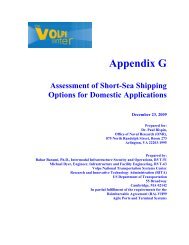ERRV Viking Islay - Marine Accident Investigation Branch
ERRV Viking Islay - Marine Accident Investigation Branch
ERRV Viking Islay - Marine Accident Investigation Branch
- No tags were found...
You also want an ePaper? Increase the reach of your titles
YUMPU automatically turns print PDFs into web optimized ePapers that Google loves.
2.10The ship - shore disconnectIt was evident that key working practices impacting on the safety of <strong>Viking</strong> <strong>Islay</strong> andher crew were at variance with specific requirements laid down in the Vroon SMS.However, the company’s own internal audit system had not detected the disconnectbetween Vroon’s performance expectations, as detailed in its SMS, and the actual workpractices being observed by members of <strong>Viking</strong> <strong>Islay</strong>’s crew.The difficulty for Vroon, which has been experienced by many other companies, wasensuring that its policies and procedures were being carried out effectively at sea.The particular hazards associated with confined space entry were addressed duringdedicated crew training sessions held before oncoming crews embarked their vessels.However, in the case of the crew members who lost their lives on <strong>Viking</strong> <strong>Islay</strong>, thistraining was ineffective.Vroon had also tried to verify and improve the effectiveness of its SMS by employingsafety coaches, who carried out monitoring and training, both in port and at sea.However, <strong>Viking</strong> <strong>Islay</strong> had not been visited as a part of this programme at the time ofthe accident. Subsequently, having identified that this was partly due to the tradingpatterns of its fleet, Vroon has employed additional coaches in order to accelerate thetraining programme.2.11Similar accidentsArguably, there can be few aspects of personal safety on board ships that havereceived more attention than the importance of following the correct procedures beforeentering an enclosed space. Very sadly, accidents such as that which occurred onboard <strong>Viking</strong> <strong>Islay</strong>, continue to happen.The lessons below have deliberately been copied from an MAIB Safety Digest articlefollowing a similar fatal accident in 2002 22 . They remain as valid now as they did then.Tragically, if learnt, they would have prevented this accident too.1. Anyone who has been at sea for some time in merchant ships will be all toofamiliar with stories of people who have entered enclosed spaces without takingthe necessary precautions, and died as the result. The lessons from suchincidents have been hammered home time and time again and still it happens.Although it is impossible to know exactly what victims are thinking before theymake an entry, it is feasible to assume they think the space is sufficiently safe towarrant entry. After all, it looks all right, so what could possibly go wrong?2. Some spaces are evidently dangerous, and there are very sound rules inplace to prevent accidents. Consult the IMDG code to know the properties andcharacteristics of dangerous bulk cargoes before entering a space where suchcargo is being, or has been carried. Follow the excellent advice in the Code ofSafe Working Practices for Merchant Seamen, which documents the proceduresfor entering enclosed spaces. The main points are: the space must alwaysbe tested before and during each entry, personnel should be standing by withsafety equipment at the entrance, and the space should be well ventilated.22 See MAIB Safety Digest 1/2002 http://www.maib.gov.uk/cms_resources/Safety%20Digest%201_2002.pdf33
















